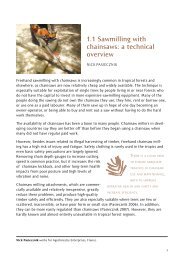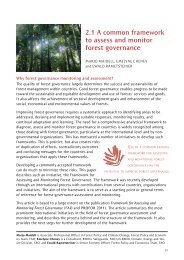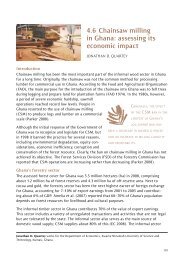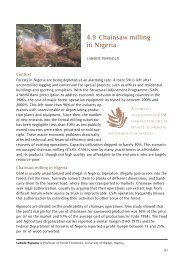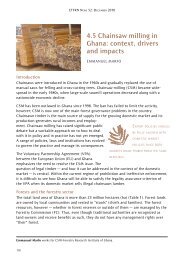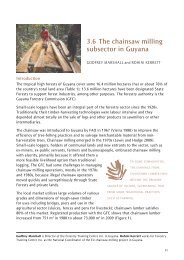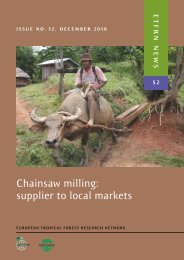Chainsaw milling: supplier to local markets - European Tropical ...
Chainsaw milling: supplier to local markets - European Tropical ...
Chainsaw milling: supplier to local markets - European Tropical ...
Create successful ePaper yourself
Turn your PDF publications into a flip-book with our unique Google optimized e-Paper software.
2.5 FiNaNcial aNalysis oF small-scalE haRvEsTiNg iN papua NEw guiNEa<br />
Timber processing, even for small-scale portable sawmill operations, is capital-intensive.<br />
Few community-based operations in pnG currently achieve the required mill production,<br />
recovery and transport arrangements for long-term financial viability of their portable<br />
sawmill operations. aggregating production and producing at a larger-scale can increase<br />
viability, but this presents political challenges for communities. high transaction costs<br />
are associated with being a part owner of a processing facility and significant continuing<br />
effort is required <strong>to</strong> ensure that the community receives an equitable return from its<br />
resource and labour inputs.<br />
access <strong>to</strong> capital <strong>to</strong> commence a portable sawmill operation is also critical <strong>to</strong> its success;<br />
harvesting a larger area can overcome problems of scale. with increased volume from a<br />
larger area, a skidder can be used <strong>to</strong> move logs <strong>to</strong> stationary mills, but this could lead <strong>to</strong><br />
impacts such as damage <strong>to</strong> the forest floor, soil erosion and water quality problems.<br />
Effective leadership, business skills, motivated and trained staff, attractive salaries and<br />
equitable distributions of surpluses are critical <strong>to</strong> the success of any community enterprise.<br />
acknowledgements<br />
This work was undertaken with financial support from the australian Centre for international<br />
agricultural research (project number FsT-2004-061). we would also like <strong>to</strong><br />
acknowledge project partners at the pnG Forest research institute and the Village<br />
Development Trust for their support and various members of the timber production<br />
community in pnG for providing information on costs and revenue.<br />
Endnote<br />
1. See, for example, FORCERT (www.forcert.org.pg).<br />
References<br />
Ambia, V. 2005. Global Forest Resources Assessment 2005: Papua New Guinea country report. PNG Forest<br />
Authority, Port Moresby.<br />
Bank of Papua New Guinea. 2009. Quarterly Economic Bulletin, September 2009. Bank of Papua New<br />
Guinea, Port Moresby.<br />
Filer, C. and N. Sekhran. 1998. Loggers, Donors and Resource Owners. National Research Institute of PNG<br />
and International Institute for Environment and Development, Port Moresby and London.<br />
Hunt, C. 2000. Marketing Eco-Timber in Papua New Guinea. Paper presented <strong>to</strong> the IUFRO Working<br />
Group 3.08 Symposium “Developing Policies <strong>to</strong> Encourage Small-scale Forestry,” Kuranda, Australia,<br />
January 9–13, 2000.<br />
49



